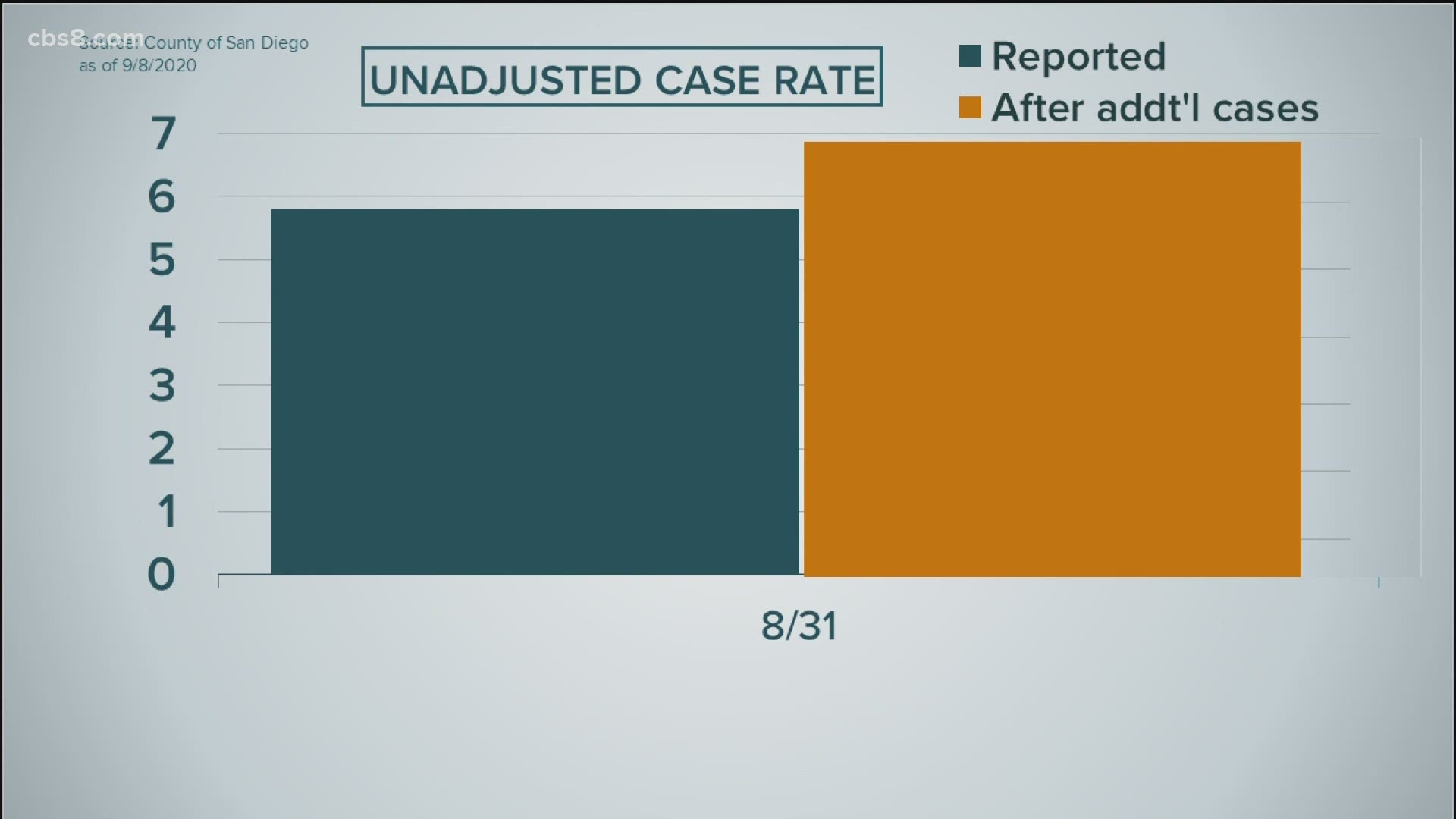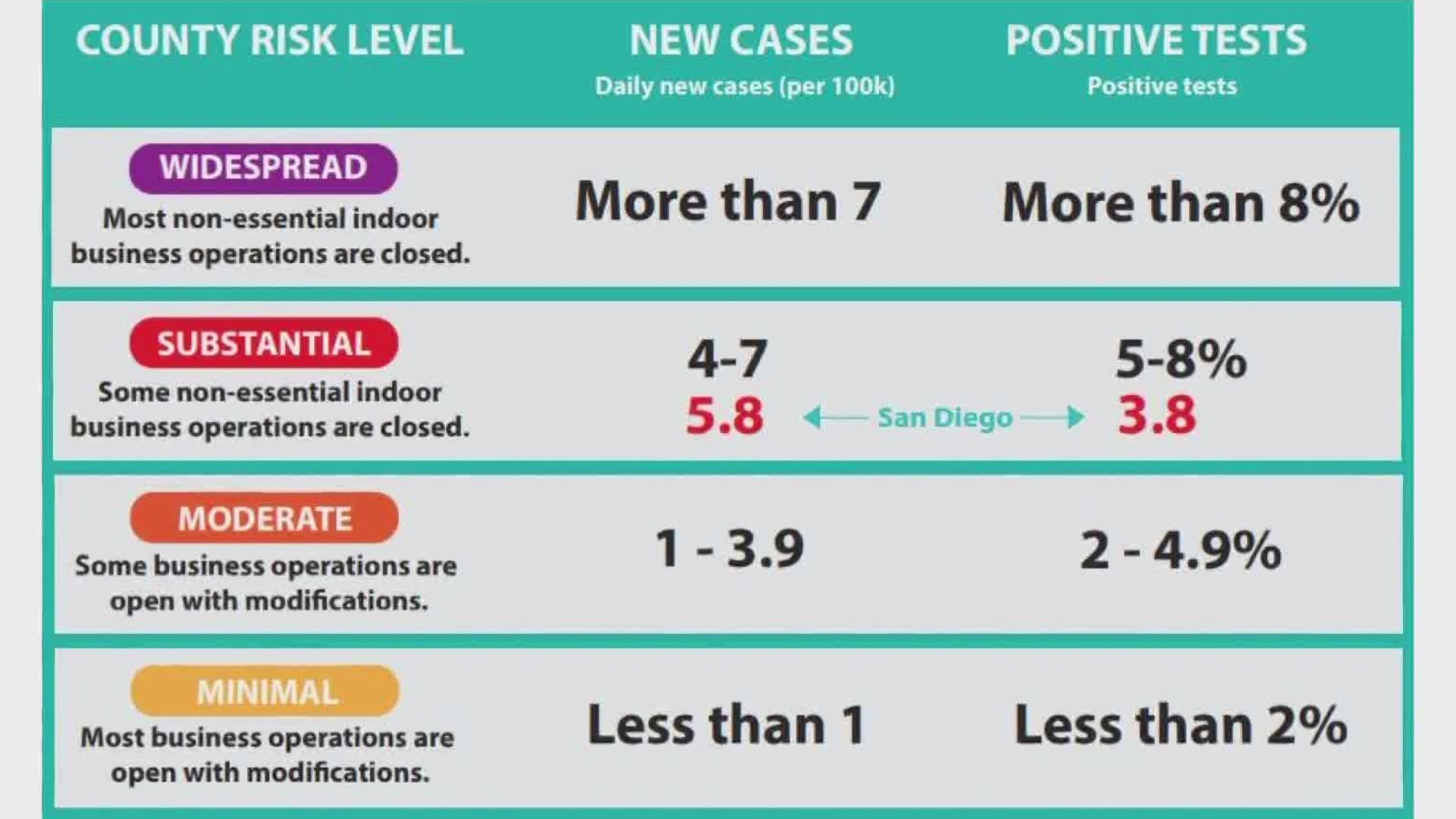SAN DIEGO — San Diego County’s coronavirus case rate increased over the last week. The state calculated it Tuesday at 6.9, just short of the 7 threshold for Tier 1 status that would require increased restrictions on businesses and schools.
However, the California Department of Public Health began penalizing counties that do not conduct enough testing compared to the state average. It determined San Diego fell short of the goal and adjusted the rate to 7.9, well within Tier 1. A county that has a rate of 7 or more for 14 consecutive days will be placed in Tier 1.
San Diego County officials dispute CDPH’s methodology because they claim it is missing data from several testing sites. Dr. Wilma Wooten, M.D., M.P.H., was unable to estimate how many test results were missing and whether it will be enough to keep the county out of Tier 1 status. The county said the state expects to resolve the data issue within two weeks and CDPH told News 8 it will not adjust San Diego’s tier while the issue is being adjudicated.
“There have been challenges and local health officers across the state are concerned about that. We are still talking with the state, but right now what is current is we are at [a case rate of] 6.9,” said Wooten.
San Diego County public health officials Wednesday reported 247 new COVID-19 infections and 12 additional fatalities, raising the region's totals to 41,324 cases and 721 deaths from the coronavirus.
Under the new metric that began earlier this month, case rates are calculated weekly on Tuesday based on a seven-day average of cases with a seven-day lag to account for testing delays. They are then calculated using “episode date,” or when the person who tested positive began feeling symptoms of COVID-19.
CDPH initially calculated San Diego had a case rate of 5.8 on August 31. A News 8 analysis of episode date data added after the rate was calculated for the same period reviewed for August 31 showed the rate increased to 6.8 after new results were returned. In a few cases where the episode date occurred more than 14 days after the results were returned, the data would never factor into the case rate because it is based on a rolling seven-day period.
The tier system, explained:
How is the case rate calculated?
CDPH calculates case rate weekly by averaging all new cases within a seven-day period and dividing it by a county’s population. The rate is then adjusted for testing volume to give credit to counties that are doing more testing or penalizing counties that aren’t doing enough.
What is the difference between an adjusted and unadjusted case rate?
An unadjusted case rate, such as San Diego County’s 6.9 rate, is based only on positive cases and population. It does not account for testing volume.
“The updated adjustment methodology takes into account both low and high testing volume (for the initial tier assignments, adjustments were only made for higher test volume). Ensuring adequate testing volume remains critical to case identification and interruption of disease transmission, particularly in communities with high test positivity. CDPH made the decision to update the adjustment scale to better reflect variations in case rates relevant to testing volume across counties and refined this after local health department feedback,” CDPH told News 8.
Is the county’s 7.9 adjusted case rate enough to put is back into Tier 1?
No single day case rate is enough to change our tier. San Diego would need to have a case rate of 7 or higher for 14 consecutive days to move into Tier 1. It needs to have a rate of 3.9 or lower for 21 consecutive days to move into Tier 3.
San Diego County disputes the testing volume data used to calculate the 7.9 rate and CDPH said on Tuesday it is holding San Diego County “harmless.”
“San Diego Public Health is undergoing a data adjudication process with CDPH to address the difference in testing volume results for San Diego residents received by the state compared to the county. Testing volume impacts the case rate adjustment and thus could impact tier assignments. If it is determined that after reconciliation there is any impact on tier metrics and subsequent tier assignments, CDPH will consider adjustment of the tier assignment accordingly,” CDPH told News 8.
The county expects the adjudication process to take two weeks.
How does the percentage of positive cases affect our tier status?
CDPH limits how high of a percentage of positive cases each county can have within each tier. San Diego is in Tier 2 and needs to have fewer than 4.9 percent of cases returned positive to move into Tier 3.
You can read the Blueprint for a Safer Economy here.


